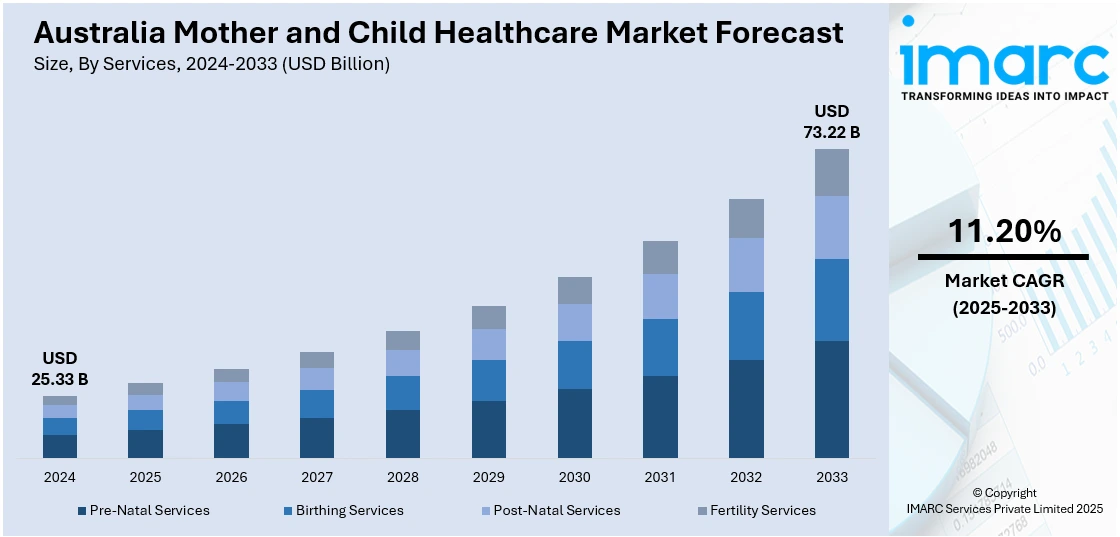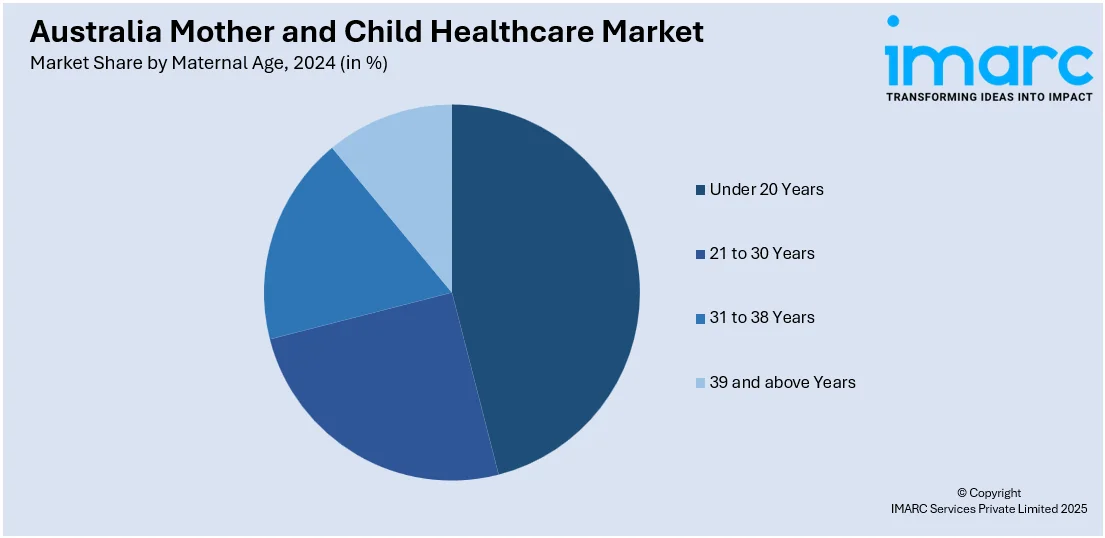
Australia Mother and Child Healthcare Market Size, Share, Trends and Forecast by Services, Maternal Age, Location, and Region, 2025-2033
Australia Mother and Child Healthcare Market Overview:
The Australia mother and child healthcare market size reached USD 25.33 Billion in 2024. Looking forward, IMARC Group expects the market to reach USD 73.22 Billion by 2033, exhibiting a growth rate (CAGR) of 11.20% during 2025-2033. The Australia mother and child healthcare market is being driven by strong government support through Medicare, rising awareness of the importance of preventive care, technological integration in maternity services, elevating demand for personalized healthcare, and targeted programs for Indigenous and rural populations, all contributing to improved accessibility, quality, and continuity of maternal and pediatric care.
|
Report Attribute
|
Key Statistics
|
|---|---|
|
Base Year
|
2024 |
|
Forecast Years
|
2025-2033
|
|
Historical Years
|
2019-2024
|
| Market Size in 2024 | USD 25.33 Billion |
| Market Forecast in 2033 | USD 73.22 Billion |
| Market Growth Rate 2025-2033 | 11.20% |
Australia Mother and Child Healthcare Market Trends:
Government Policy Support and Public Healthcare Infrastructure
One of the key drivers of the Australia mother and child healthcare market is the strong backing from government policies and the establishment of an extensive public healthcare infrastructure. Australia has a well-developed universal healthcare system called Medicare, which provides subsidized or free access to a large number of important maternal and pediatric healthcare services. These include prenatal visits, childbirth assistance, neonatal testing, and postnatal visits. Government policies like the National Maternity Services Plan and Australia's Long Term National Health Plan also guarantee the consistent provision of high-quality maternal and child health care in urban and rural settings. Specifically, focused policies are directed towards decreasing maternal and infant mortality rates, providing early childhood immunization, and mental health care for new mothers. The Child and Family Health Services (CFHNs) provide a multidisciplinary model with midwives, nurses, psychologists, and allied health professionals to track developmental milestones and intervene early on health concerns. In addition to this, public investments in digital health records, telehealth growth, and rural healthcare outreach have enhanced accessibility and efficiency, particularly for marginalized groups. This publicly supported healthcare safety net substantially fuels demand for maternal and child healthcare services, providing equitable access and stimulating early interventions that enhance long-term health outcomes.

To get more information on this market, Request Sample
Rising Consumer Awareness and Demand for Personalized, Preventive Care
Another factor driving Australia's mother and child healthcare market is the increasing consumer demand for individualized, preventive, and wellness-focused care. Modern Australian families are better educated, more health-aware, and more engaged in controlling maternal and child health. This is a result of increased access to digital health data, parenting knowledge websites, internet forums, and extensive utilization of health-monitoring apps. Expectant and new parents are more involved in birthing plan decisions, prenatal testing, dietary supplement, breastfeeding assistance, and development monitoring. This change has created demand for personalized care like private midwifery, holistic prenatal care, genetic testing, organic baby care products, and early intervention therapy. Parents are looking not only for treatment of disease but advice for best development, mental wellness, and prevention of disease. This consumer culture has also brought about the emergence of boutique maternity clinics, private pediatricians, and integrative health services with conventional and alternative therapies like acupuncture, yoga, and naturopathy.
Australia Mother and Child Healthcare Market Segmentation:
IMARC Group provides an analysis of the key trends in each segment of the market, along with forecasts at the region/country level for 2025-2033. Our report has categorized the market based on services, maternal age, and location.
Services Insights:
- Pre-Natal Services
- Birthing Services
- Post-Natal Services
- Fertility Services
The report has provided a detailed breakup and analysis of the market based on the services. This includes pre-natal services, birthing services, post-natal services, and fertility services.
Maternal Age Insights:

- Under 20 Years
- 21 to 30 Years
- 31 to 38 Years
- 39 and above Years
A detailed breakup and analysis of the market based on the maternal age have also been provided in the report. This includes under 20 years, 21 to 30 years, 31 to 38 years, and 39 and above years.
Location Insights:
- Hospitals
- Nursing Homes and Clinics
- In-Home Services
- Others
The report has provided a detailed breakup and analysis of the market based on the location. This includes hospitals, nursing homes and clinics, in-home services, and others.
Regional Insights:
- Australia Capital Territory & New South Wales
- Victoria & Tasmania
- Queensland
- Northern Territory & Southern Australia
- Western Australia
The report has also provided a comprehensive analysis of all the major regional markets, which include Australia Capital Territory & New South Wales, Victoria & Tasmania, Queensland, Northern Territory & Southern Australia, and Western Australia.
Competitive Landscape:
The market research report has also provided a comprehensive analysis of the competitive landscape. Competitive analysis such as market structure, key player positioning, top winning strategies, competitive dashboard, and company evaluation quadrant has been covered in the report. Also, detailed profiles of all major companies have been provided.
Australia Mother and Child Healthcare Market News:
- February 2025: The Australian government announced that it would be investing AUD 28 million to establish a world-class Nurses and Midwives Academy at Melbourne's Epworth Hospital. This facility will feature advanced digital technologies, including a Blended Learning Simulation Suite, to provide immersive training for nurses and midwives nationwide, especially benefiting rural and remote communities.
- May 2024: The Queensland Government announced an AUD 39 million investment to establish 30 new mother-baby beds across six locations, including Townsville, Cairns, and Logan. This initiative aims to provide specialist perinatal mental healthcare, recognizing that approximately one in five mothers experience psychological distress during the perinatal period.
- May 2024: The Australian government allocated AUD 56.5 million to enhance midwifery care. This funding aims to expand the Medicare Benefits Schedule (MBS), allowing endorsed midwives to offer longer appointments and introduce new items for complex antenatal care.
Australia Mother and Child Healthcare Market Report Coverage:
| Report Features | Details |
|---|---|
| Base Year of the Analysis | 2024 |
| Historical Period | 2019-2024 |
| Forecast Period | 2025-2033 |
| Units | Billion USD |
| Scope of the Report |
Exploration of Historical Trends and Market Outlook, Industry Catalysts and Challenges, Segment-Wise Historical and Future Market Assessment:
|
| Services Covered | Pre-Natal Services, Birthing Services, Post-Natal Services, Fertility Services |
| Maternal Ages Covered | Under 20 Years, 21 to 30 Years, 31 to 38 Years, 39 and above Years |
| Locations Covered | Hospitals, Nursing Homes and Clinics, In-Home Services, Others |
| Regions Covered | Australia Capital Territory & New South Wales, Victoria & Tasmania, Queensland, Northern Territory & Southern Australia, Western Australia |
| Customization Scope | 10% Free Customization |
| Post-Sale Analyst Support | 10-12 Weeks |
| Delivery Format | PDF and Excel through Email (We can also provide the editable version of the report in PPT/Word format on special request) |
Key Questions Answered in This Report:
- How has the Australia mother and child healthcare market performed so far and how will it perform in the coming years?
- What is the breakup of the Australia mother and child healthcare market on the basis of services?
- What is the breakup of the Australia mother and child healthcare market on the basis of maternal age?
- What is the breakup of the Australia mother and child healthcare market on the basis of location?
- What is the breakup of the Australia mother and child healthcare market on the basis of region?
- What are the various stages in the value chain of the Australia mother and child healthcare market?
- What are the key driving factors and challenges in the Australia mother and child healthcare market?
- What is the structure of the Australia mother and child healthcare market and who are the key players?
- What is the degree of competition in the Australia mother and child healthcare market?
Key Benefits for Stakeholders:
- IMARC’s industry report offers a comprehensive quantitative analysis of various market segments, historical and current market trends, market forecasts, and dynamics of the Australia mother and child healthcare market from 2019-2033.
- The research report provides the latest information on the market drivers, challenges, and opportunities in the Australia mother and child healthcare market.
- Porter's five forces analysis assist stakeholders in assessing the impact of new entrants, competitive rivalry, supplier power, buyer power, and the threat of substitution. It helps stakeholders to analyze the level of competition within the Australia mother and child healthcare industry and its attractiveness.
- Competitive landscape allows stakeholders to understand their competitive environment and provides an insight into the current positions of key players in the market.
Need more help?
- Speak to our experienced analysts for insights on the current market scenarios.
- Include additional segments and countries to customize the report as per your requirement.
- Gain an unparalleled competitive advantage in your domain by understanding how to utilize the report and positively impacting your operations and revenue.
- For further assistance, please connect with our analysts.
 Request Customization
Request Customization
 Speak to an Analyst
Speak to an Analyst
 Request Brochure
Request Brochure
 Inquire Before Buying
Inquire Before Buying




.webp)




.webp)












